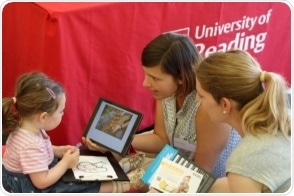Seeing images of vegetables can boost children’s intake – new eBooks launched to encourage children to eat their greens

Dr Natalie Masento presenting the eBooks
A variety of new resources, based on the evidence that children who are exposed to pictures of vegetables are more likely to eat them, have been launched as part of the See & Eat project, an initiative funded by European Institute of Innovation and Technology (EIT) Food, led by Professor Carmel Houston-Price at the University of Reading and supported by the British Nutrition Foundation (BNF).
24 new eBooks, designed to help parents familiarize their young children with a greater variety of vegetables, are now available to download for free from the See & Eat Parent Resource website, along with numerous other resources, including meal planners, shopping lists, and family-friendly recipes, developed to support parents and carers in encouraging their children to eat more vegetables.
The ‘See & Eat’ eBooks each tell the farm to fork journey of a different vegetable and can be personalized with pictures, videos and text. The eBooks have been developed based on research showing that hard-copy books about vegetables help to familiarize children with new foods and, ultimately, help them to eat a wider variety.
The project team is currently conducting a study to understand whether extra interactivity and personalization through eBooks, such as adding photos or videos of shopping for, preparing or eating vegetables, can support children to become even more receptive to new vegetables.
Dr Natalie Masento, a collaborator on the project at the University of Reading, comments:
It is well established that children often need 10-15 exposures to new foods before they accept them into their diets. But, having to prepare different vegetables on more than ten occasions, without them being eaten, can be very frustrating – and costly – for many parents. Research has shown, however, that children’s acceptance of new foods can be boosted purely by a food’s visual familiarity, for instance by looking at pictures.
The theory of food familiarization through picture books is well accepted and we hope that, through easy-to-access eBooks, even more parents will be able to use this tool to support their children to eat their vegetables. Our current study – exploring the effects of personalization and interactivity on children’s receptiveness to new vegetables – is looking positive and we’re excited to see the results next year.”
All of the See & Eat eBooks are free to download and are currently available in English and Italian. Next year, the eBooks will be launched in three further languages.
The project has been funded by EIT Food, the innovation community on food of the European Institute of Innovation and Technology (EIT), a body of the EU, under Horizon 2020, the EU Framework Program for Research and Innovation. Partners involved in the project include: University of Reading, University of Torino, The European Food Information Council (EUFIC), Open University and Colruyt Group.